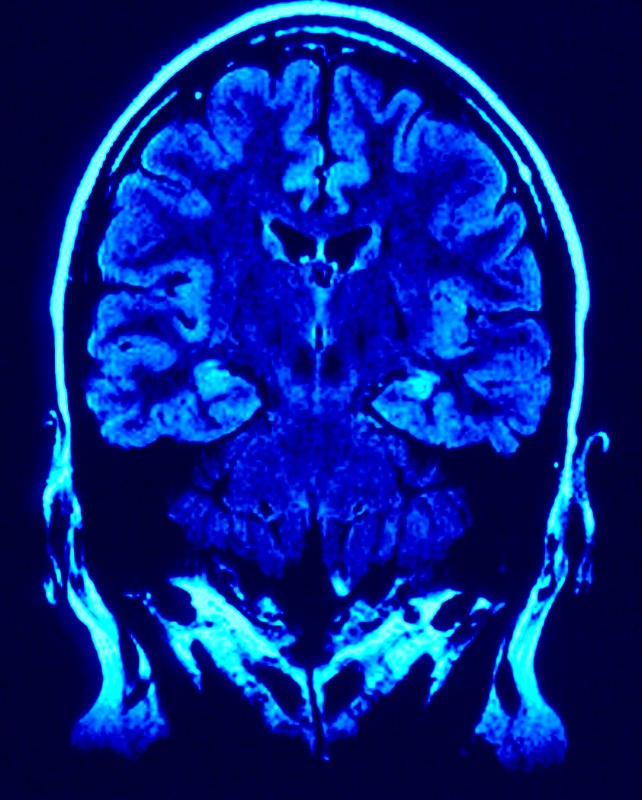 When my my Mother’s sister, Pat, was seven years old, she was in a car-bicycle accident that resulted in some very serious brain trauma. She spent better than a year learning to walk and talk again, and although there were some lasting personality changes, she went on to earn a nursing degree and live an independent life. When I think of My Aunt Pat, I can’t help but marvel at what the human brain can do. Damaged brain tissue does not re-grow, but still the brain can find a way to rewire itself to circumvent damaged areas.
When my my Mother’s sister, Pat, was seven years old, she was in a car-bicycle accident that resulted in some very serious brain trauma. She spent better than a year learning to walk and talk again, and although there were some lasting personality changes, she went on to earn a nursing degree and live an independent life. When I think of My Aunt Pat, I can’t help but marvel at what the human brain can do. Damaged brain tissue does not re-grow, but still the brain can find a way to rewire itself to circumvent damaged areas.
Fortunately, it doesn’t take trauma to the brain for it to demonstrate its plasticity. Our neural structures can be modified with the right training. Studies have shown task-specific increases in gray matter as a result of things such as learning an abstract skill or increasing aerobic activity. Cross-sectional studies have established that differences in performance abilities are associated with differences in regional gray matter. To me this begs the question: Can we consciously increase gray matter in specific regions of the brain?
In their article in Psychiatry Research: Neuroimaging, Hölzel et al. (1) found that an eight-week program of Mindfulness-Based Stress Reduction (MBSR) training resulted in increases in gray matter density in areas of the brain associated with learning and memory processes, emotion control, self-referential processing and perspective taking. These increases were found in the left hippocampus, posterior cingulated cortex (PCC), the temporo-paretal junction (TPJ) and the cerebellum.
Mindfulness meditation has been shown to have positive effects on well-being and quality of life that can last long after the time of formal meditation. Mindfulness-based intervention techniques have been used to reduce the symptoms of a number of disorders including anxiety, depression and substance abuse to name just a few. This meditation practice involves developing an awareness of the present-moment experience using a compassionate and nonjudgmental stance.
 The MBSR-based programs typically involve weekly group meetings, formal mindfulness training (a body scan, mindful yoga and sitting meditation) and daily home practice. During the body scan, attention is guided throughout the whole body, ending with an awareness of the body as a complete whole. Mindful yoga involves gentle stretching and slow movements coordinated with the breath. Emphasis is placed on being aware of the experience of every moment and a non-harming attitude towards the body. Finally, sitting meditation typically begins with awareness of the breath and then evolves to awareness of other sensations, thoughts and emotions. With time, meditation can expand to an awareness of one’s presence in the here and now.
The MBSR-based programs typically involve weekly group meetings, formal mindfulness training (a body scan, mindful yoga and sitting meditation) and daily home practice. During the body scan, attention is guided throughout the whole body, ending with an awareness of the body as a complete whole. Mindful yoga involves gentle stretching and slow movements coordinated with the breath. Emphasis is placed on being aware of the experience of every moment and a non-harming attitude towards the body. Finally, sitting meditation typically begins with awareness of the breath and then evolves to awareness of other sensations, thoughts and emotions. With time, meditation can expand to an awareness of one’s presence in the here and now.
In the study described by Hölzel et al., eighteen volunteers underwent MRI scanning two weeks before beginning an eight-week MBSR program. Sixteen volunteers completed the program and underwent MRI scanning again roughly two weeks after the program ended. The scans of this group were compared to those of seventeen control volunteers, who were also scanned twice in the same time frame but did not participate in the mindfulness program. In addition, both groups filled out the Five Facet Mindfulness Questionnaire (2) at the beginning and end of the study. The authors report that they got usable information from both time-points for 14 MBSR and 14 control members.
The results of paired t-tests within the MBSR group showed an increase in gray matter concentration in a small cluster in the left hippocampus. In addition, increases in gray matter concentration were found in regions of the PCC, TPJ and cerebellum. No significant increases or decreases in gray matter were identified in the control group between the two time-points.
The structure of the human brain can change in response to training. Although the cellular and molecular mechanisms for this phenomenon are still a mystery, this study showed morphological changes in regions of the brain associated with mental health as a result of a mindfulness-based program. These findings are supported by previous studies showing that MBSR leads to improvements in psychological health and well-being (3).
The answer to my question seems to be yes; there are ways to consciously increase gray matter in areas of the brain that could support improved mental functioning. To me these results are exciting and encouraging. Who wouldn’t like a better sense of well-being? I like yoga. I would love to learn to meditate, and now I have even more inspiration to do so.
References
- Hölzel BK, Carmody J, Vangel M, Congleton C, Yerramsetti SM, Gard T, & Lazar SW (2011). Mindfulness practice leads to increases in regional brain gray matter density. Psychiatry research, 191 (1), 36-43 PMID: 21071182
- Baer, R.A. et al. (2006) Using Self-reporting assessment methods to explore facets of mindfulness. Assessment 13, 27–45.
- Grossman, P. et al. (2004) Mindfulness-based stress reduction and health benefits. A meta-analysis. J Psychosom Res. 57, 35–43.

nice
This is very interesting. It is neurogenic nitric oxide that produces many of the physiological effects of mindfulness meditation.
Neurogenic NO is how the brain meta-programs itself. The vasodilatation observed on fMRI BOLD is due to neurogenic release of NO causing vasodilatation.
Very informative article. Lot of healing and health benefits of meditation has already been documented and people are already beginning to realize the benefits. I have even heard doctors and psychologists are prescribing meditation courses as a therapy. I am going to attend this seminar on 9th April http://meditation.yoga.us/ at Secacus NJ
Jiddu Krishnamurti telling a joke…
“There are three monks, who had been sitting in deep meditation for many years amidst the Himalayan snow peaks, never speaking a word, in utter silence. One morning, one of the three suddenly speaks up and says, ‘What a lovely morning this is.’ And he falls silent again. Five years of silence pass, when all at once the second monk speaks up and says, ‘But we could do with some rain.’ There is silence among them for another five years, when suddenly the third monk says, ‘Why can’t you two stop chattering?”
http://www.katinkahesselink.net/kr/jokes.html
http://seaunaluzparaustedmismo.blogspot.com/
Great article. Mindfulness is indeed perfect for many health related benefits, including reducing stress and anxiety. I have practiced this techniques, and I can certainly say that it works.
Marika
Guzmán,
Thank you for the joke, it made my Monday morning!
Thanks for all the comments. It is encouraging to hear that meditation is helping people.
Not long before I started meditation and being mindful, I was completely out of control of my life. I felt like I was just coursing through life, doing things in routine, and I hated having to wake up everyday and live my boring, uneventful life. Later I found myself unproductive and lost, until my friends suggested that I just let go of everything that is bothering me and try to pick myself up piece by piece. Through meditation classes and practicing mindfulness, I was able to slowly understand myself and what I truly want, eventually finding myself calmer and more at peace. It does help to stop for a while, especially when there is chaos all around
Salinya, I am glad to hear that mindfulness and meditation worked so well for you. I am still trying to find a rhythm that works for me so that I take some “mindful” time, and it is good to hear people who have had such positive experiences.